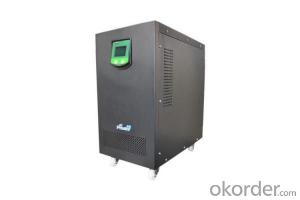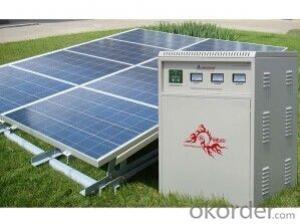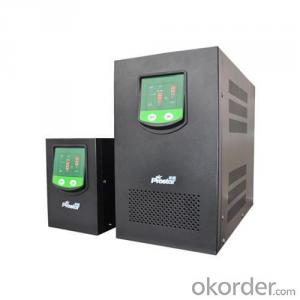Off grid Solar power system PR-SAS2000 with battery tank 1600W
- Loading Port:
- Tianjin
- Payment Terms:
- TT OR LC
- Min Order Qty:
- 10 pc
- Supply Capability:
- 10000 pc/month
OKorder Service Pledge
OKorder Financial Service
You Might Also Like
Item specifice
Specifications
1.Supply 2 work modes: to save electricity bill or to supply long time power backup.
2. Supply battery tank,high integrated.
1- Heat Sink: Aluminum heat sink to dissipate controller heat.
2- LCD: Display the status and data.
3- Battery LED indicator: Three states of battery LED indicator show charging status.
4- Charging LED indicator: Indicate that the battery is charging or not.
5- Fault LED indicator: Indicate that controller faults.
6- Buttons: Browse or modify all parameters.
7- RS-232 port: Monitor controller by PC and update controller software.
8- RS-485 port: Monitor controller by PC and update controller software.
9- RTC battery: Power to RTC, battery model is CR2032.
10- Remote Temperature Sensor port(MC1.5-5.08-2L)
Connection for a RTS (Remote Temperature Sensor, optional) to remotely monitor battery temperature.
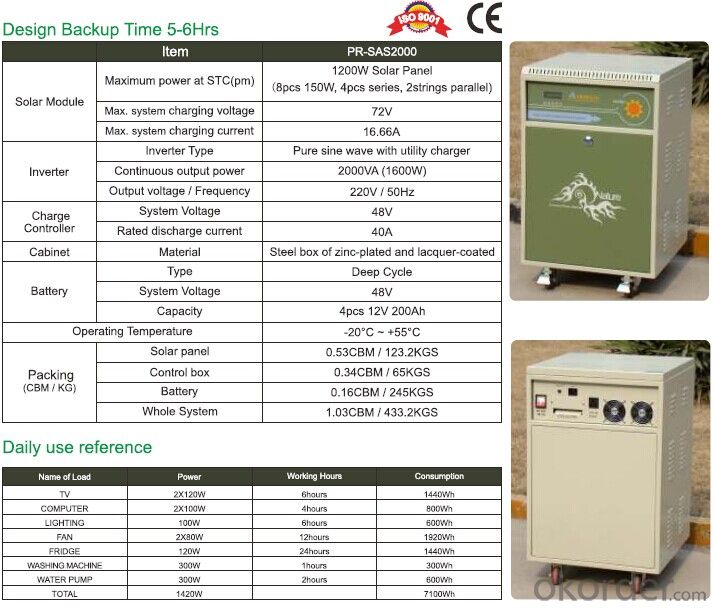
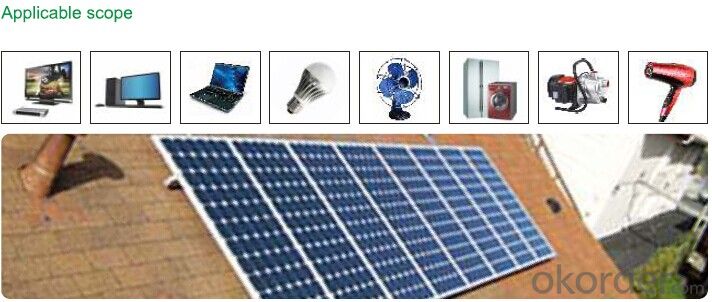
FAQ
1. How do I decide which system is right for me ?
For protection from long outages, include a generator or solar panels in your Must solar system. Shorter outages can be handled by a battery-only system.
2. Where my system will be installed ?
Must solar systems are usually wall-mounted near a home's main electrical (circuit breaker) panel.
3. How do I install my system ?
A solar backup inverter is connected to a home electric system , we will supply detailed installation manual and videos for our customers .
- Q:How does the presence of birds or other wildlife affect the performance of solar panels?
- Solar panels may be affected by the presence of birds or other wildlife in various ways. One of the primary concerns is the potential for bird droppings to accumulate on the panel's surface. This can lead to a layer of dirt and debris, reducing the amount of sunlight that can reach the solar cells. Consequently, the efficiency of the panels may decrease, resulting in a decline in overall performance. Another issue arises from the possibility of birds or other wildlife building nests or habitats near or on the solar panel systems. These nests can obstruct the sunlight from reaching the panels, leading to a decrease in energy production. Moreover, if these nests are constructed in close proximity to the panels, they can potentially cause damage to the panels or their mounting structures. Furthermore, larger birds such as raptors or pigeons may occasionally perch on the solar panels, causing physical harm to the panels or the wiring. This can result in malfunctions or a reduction in electrical output. To address these potential issues, there are several available solutions. One common approach involves using deterrents like bird spikes, netting, or scare devices to prevent birds from landing or nesting on the panels. Regular cleaning and maintenance of the panels are also crucial to eliminate any bird droppings or debris that may accumulate. Additionally, designing solar panel systems with bird-friendly features in mind can help minimize the impact on wildlife. For instance, incorporating gaps or spaces between panels can discourage birds from nesting while still allowing sufficient airflow for cooling. In conclusion, although the presence of birds or other wildlife may pose challenges for solar panels, implementing preventive measures and maintenance practices can help ensure optimal performance and prolong the system's lifespan.
- Q:Can solar energy systems be used in areas with limited access to solar energy installation services?
- Yes, solar energy systems can still be used in areas with limited access to solar energy installation services. There are several ways to overcome this challenge, such as providing training and resources to local communities to enable them to install and maintain their own solar energy systems. Additionally, advancements in technology have made solar panels more portable and easier to install, allowing for greater flexibility in remote or off-grid locations.
- Q:How does the cost of solar energy compare to other energy sources?
- The cost of solar energy has become increasingly competitive with other energy sources in recent years. Initially, the high installation costs and limited efficiency of solar panels made it more expensive compared to traditional energy sources such as fossil fuels. However, advancements in technology, economies of scale, and supportive government policies have significantly reduced the cost of solar energy. Today, the cost of solar energy is rapidly declining, making it one of the most affordable and competitive forms of energy. In many regions, solar power is already cheaper than coal and natural gas, which were traditionally the cheapest sources of energy. This trend is expected to continue as solar technology continues to improve and become more efficient. One of the main reasons for the cost reduction in solar energy is the decreasing prices of solar panels. Over the years, there has been a significant drop in the prices of photovoltaic (PV) modules, the key component in solar panels. Additionally, the manufacturing process has become more streamlined and efficient, leading to cost savings. Furthermore, the operational costs of solar energy are relatively low since sunlight, the primary fuel source, is abundant and free. Compared to fossil fuel-based power plants, solar energy systems require less maintenance and have a longer operational lifespan, resulting in lower operating costs over the long term. Government incentives and policies have also played a crucial role in reducing the cost of solar energy. Many countries and regions offer financial incentives, tax credits, grants, and subsidies to promote the adoption of solar energy. These initiatives make solar installations more affordable for consumers and encourage investment in solar technology, driving economies of scale and further reducing costs. In summary, the cost of solar energy has become highly competitive with other energy sources due to technological advancements, economies of scale, and supportive government policies. As solar energy continues to become more affordable, it is expected to play a significant role in the global energy transition, providing a clean, sustainable, and cost-effective alternative to traditional energy sources.
- Q:Are there any noise or sound issues with solar energy systems?
- Solar energy systems do not typically cause noise or sound problems. Unlike fossil fuel power plants or wind turbines, solar panels do not have any components that move and create noise. They simply transform sunlight into electricity using photovoltaic cells, which is a quiet process. The only potential noise issue with solar energy systems could come from the inverters, which convert the direct current (DC) generated by the panels into alternating current (AC) for use in homes or businesses. However, modern inverters are designed to operate silently or produce minimal noise levels, often comparable to the background hum of household appliances. Consequently, noise or sound problems are generally not a concern with solar energy systems.
- Q:Can solar energy systems be used in areas prone to earthquakes?
- Yes, solar energy systems can be used in areas prone to earthquakes. While earthquakes can pose a risk to any infrastructure, including solar panels, proper design and installation can mitigate potential damage. Reinforced mounting structures and flexible connectors can help absorb vibrations and prevent panels from dislodging. Additionally, solar energy systems are decentralized, meaning that even if some panels are affected by an earthquake, the rest of the system can continue to operate. Overall, with careful planning and engineering, solar energy systems can be used effectively in earthquake-prone areas.
- Q:Can a solar energy system be used to power electric vehicles?
- Yes, a solar energy system can be used to power electric vehicles. Solar panels can generate electricity that can be stored in batteries and used to charge the batteries of electric vehicles. This can provide a sustainable and renewable source of energy for powering electric vehicles.
- Q:Can solar energy systems be connected to the existing power grid?
- Yes, solar energy systems can be connected to the existing power grid. This is known as grid-tied or grid-connected solar systems. In this setup, solar panels generate electricity from sunlight, which is then converted into usable AC power by inverters. This AC power is then fed into the existing power grid, supplementing the electricity supply from the utility company. Grid-tied solar systems offer several advantages. Firstly, they allow homeowners and businesses to reduce their reliance on fossil fuel-based electricity and lower their carbon footprint. Additionally, excess electricity generated by the solar panels can be sent back to the grid, resulting in net metering or feed-in tariffs, where the utility company credits the system owner for the excess power. This can lead to significant cost savings or even revenue generation. Furthermore, grid-tied systems provide a reliable and stable electricity supply. During times when the solar panels are not generating enough power, such as at night or during cloudy weather, electricity can be drawn from the grid. Conversely, when the panels produce more electricity than is being used, the excess is sent back to the grid, ensuring a continuous and uninterrupted power supply. It's important to note that the installation and connection of grid-tied solar systems may require the approval and coordination of the local utility company, as well as compliance with relevant regulations and safety standards. However, overall, the ability to connect solar energy systems to the existing power grid makes them a versatile and beneficial renewable energy solution.
- Q:How do solar energy systems impact the reduction of fossil fuel consumption?
- Solar energy systems have a significant impact on the reduction of fossil fuel consumption. One of the main advantages of solar energy is that it harnesses power from the sun, which is a renewable source of energy. This means that solar energy systems do not require the burning of fossil fuels, such as coal or natural gas, to generate electricity. By using solar energy, we can reduce our dependency on fossil fuels for electricity generation, thereby lowering our carbon footprint and mitigating the negative environmental impacts associated with fossil fuel consumption. Solar energy systems also contribute to the reduction of fossil fuel consumption through the concept of net metering. Net metering allows individuals or businesses with solar panels to sell excess electricity generated back to the grid. This means that during times of high solar energy production, when the system generates more electricity than is being used, the excess energy is fed back into the grid. As a result, less electricity needs to be produced by fossil fuel-based power plants to meet the demand, reducing the overall consumption of fossil fuels. Furthermore, the adoption of solar energy systems can lead to a decrease in the demand for fossil fuel-based electricity, which in turn can drive down the price of electricity. This price reduction can make renewable energy more economically competitive, encouraging greater adoption of solar energy systems and further reducing the demand for fossil fuels. In summary, solar energy systems play a vital role in reducing fossil fuel consumption. By utilizing the sun's energy, solar power systems eliminate the need for burning fossil fuels for electricity generation. Through net metering and the potential for price reductions, solar energy systems contribute to the overall reduction of fossil fuel consumption, promoting a cleaner and more sustainable energy future.
- Q:Can solar energy systems be used for desalination?
- Yes, solar energy systems can be used for desalination. Solar-powered desalination plants use solar energy to power the desalination process, typically through the use of solar panels or solar thermal collectors. This renewable energy source can be harnessed to convert saltwater into fresh water, making it an environmentally friendly and sustainable solution for water scarcity in coastal and arid regions.
- Q:Can solar energy systems be used for powering outdoor surveillance cameras?
- Yes, solar energy systems can definitely be used for powering outdoor surveillance cameras. Solar energy systems consist of solar panels that convert sunlight into electricity, and this electricity can be used to power various devices, including outdoor surveillance cameras. By installing solar panels near the cameras, the captured sunlight can be converted into electrical energy, which can then be stored in batteries or used directly to power the cameras. This eliminates the need for traditional power sources or running electrical wires to remote locations, making it a cost-effective and eco-friendly solution. Additionally, solar energy systems can provide a reliable and continuous power source, even in areas with limited access to electricity, ensuring uninterrupted surveillance capabilities.
1. Manufacturer Overview |
|
|---|---|
| Location | |
| Year Established | |
| Annual Output Value | |
| Main Markets | |
| Company Certifications | |
2. Manufacturer Certificates |
|
|---|---|
| a) Certification Name | |
| Range | |
| Reference | |
| Validity Period | |
3. Manufacturer Capability |
|
|---|---|
| a)Trade Capacity | |
| Nearest Port | |
| Export Percentage | |
| No.of Employees in Trade Department | |
| Language Spoken: | |
| b)Factory Information | |
| Factory Size: | |
| No. of Production Lines | |
| Contract Manufacturing | |
| Product Price Range | |
Send your message to us
Off grid Solar power system PR-SAS2000 with battery tank 1600W
- Loading Port:
- Tianjin
- Payment Terms:
- TT OR LC
- Min Order Qty:
- 10 pc
- Supply Capability:
- 10000 pc/month
OKorder Service Pledge
OKorder Financial Service
Similar products
New products
Hot products
Hot Searches
Related keywords
